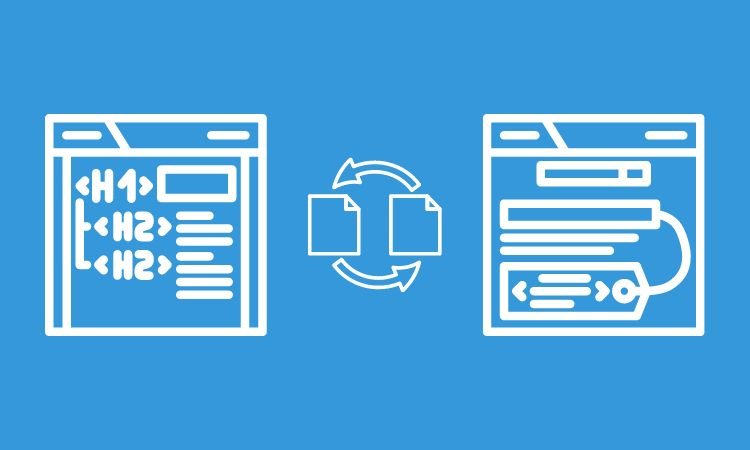Table of Contents
Duplicate H1 and title tag issues can significantly hinder a website’s search engine optimization (SEO) and overall performance. Resolving these issues is crucial for providing a seamless user experience and achieving better visibility in search engine results. In this comprehensive guide, we will explore the intricacies of duplicate H1 and title tags, how to identify them, and the steps you can take to resolve these issues effectively.
What Are Duplicate H1 and Title Tags?
The H1 tag is the main heading of a webpage and plays a vital role in indicating the content of the page to search engines and users alike. The title tag is the text displayed on the browser tab and in search engine results, providing a brief summary of the page’s content.
Duplicate H1 and title tags occur when multiple pages on a website have identical or nearly identical H1 or title tags. This can confuse search engines and users, making it challenging to understand the purpose and content of each page.
Why are Duplicate H1 and Title Tags Problematic?
There are several reasons why this issue can be detrimental to your website:
- SEO Impact
Search engines prefer unique and descriptive tags to differentiate between pages and accurately understand the content. Duplicate tags can lead to lower rankings and reduced visibility. - User Experience
When users encounter duplicate tags, they may struggle to find the specific information they are looking for, resulting in a poor user experience. - Keyword Cannibalization
Duplicate tags can lead to keyword cannibalization, where multiple pages compete for the same search terms, diluting your SEO efforts and confusing search engines.
Duplicate H1 and title tags can harm your website’s SEO impact, user experience, and lead to keyword cannibalization, ultimately affecting your site’s visibility and the effectiveness of your SEO strategy. By addressing these issues, you can create a more cohesive and successful online presence.
Tools to Find Duplicate H1 and Title Tags
Identifying duplicate H1 and title tags on your website is a crucial first step in resolving the issue. Here are some effective tools and methods to help you find duplicate tags:
SEO Audit Tools to Identify Duplicate H1 and Title Tags
SEO audit tools such as SEMrush, Ahrefs, and Moz offer reports that identify pages with duplicate H1 and title tags. These tools can scan your website and provide insights into potential issues.
Here are the steps to use these tools for identifying and resolving duplicate H1 and title tag issues:
- Set Up Your Account. If you haven’t already, sign up for an account with an SEO audit tool of your choice, such as SEMrush, Ahrefs, or Moz.
- Run a Site Audit. Once you’re logged in, run a site audit by entering your website URL. This audit will scan your website’s pages and gather data on various SEO factors, including H1 and title tags.
- Analyze the Report. After the audit is complete, the tool will generate a report with detailed information on your website’s performance. Look for sections related to “title tags” and “H1 tags” to identify any duplicates.
- Identify Duplicate Tag. The tool will flag pages with duplicate H1 and title tags. You can usually filter the report to focus specifically on these issues.
- Review and Prioritize. Review the list of pages with duplicate tags and prioritize them based on their impact on SEO and user experience.
- Create a Plan. Develop a plan to revise or adjust the tags as needed. This may involve rewriting titles and H1s, consolidating content, or other adjustments.
- Implement Changes. Make the necessary changes to the duplicate H1 and title tags identified in the report.
- Monitor Results. Continue to use the audit tool to monitor your website and ensure that duplicate tags do not resurface.
By leveraging SEO audit tools, you can efficiently identify and address this issues, ensuring that your website remains optimized and performs well in search engine rankings.
Identify Duplicate H1 and Title Tags Using Screaming Frog
Screaming Frog is a popular website crawler that allows you to analyze your website’s structure and identify duplicate tags. The tool provides detailed reports on H1 and title tags, making it easy to spot duplicates.
Here’s how to use Screaming Frog to find and fix duplicate H1 and title tags:
- Download and Install. Download and install the Screaming Frog SEO Spider tool on your computer.
- Crawl Your Website. Launch the tool and enter your website URL to begin the crawl. Screaming Frog will scan your website and gather data on various aspects of your pages.
- Navigate to Reports. Once the crawl is complete, navigate to the “Page Titles” and “Headings” tabs to view information on title tags and H1 tags, respectively.
- Filter Duplicates. In each tab, use the filters provided to identify pages with duplicate title tags and H1 tags. Look for rows where the same tag appears on multiple pages.
- Review Duplicate Tags. Review the pages with duplicate tags and assess the severity of the issue.
- Create a Plan. Develop a plan to address the duplicate tags. This may include rewriting tags or consolidating content.
- Implement Changes. Make the necessary changes to the tags identified as duplicates.
- Re-crawl Your Site. After making changes, re-crawl your website with Screaming Frog to ensure the duplicates have been resolved.
Using Screaming Frog to crawl and analyze your website allows you to pinpoint and resolve duplicate tags with precision, improving your website’s structure and SEO performance.
Identify Duplicate H1 and Title Tags Using Google Search Console
Google Search Console offers valuable information about your website’s performance and potential SEO issues. It can help you identify pages with similar tags and other optimization concerns.
Here’s how to use Google Search Console to identify duplicate H1 and title tags:
- Set Up Your Account. If you haven’t already, set up an account with Google Search Console and add your website.
- Navigate to the Coverage Report. Log in to your account and go to the “Coverage” report under the “Index” section.
- Review Errors and Warnings. Look for any errors or warnings related to “Duplicate, submitted URL not selected as canonical” or similar issues that may indicate duplicate tags.
- Investigate Duplicate Tags. Click on the error or warning to see the specific pages affected. This may provide insights into duplicate H1 and title tags.
- Prioritize and Plan. Prioritize the pages with duplicate tags and create a plan to address the issues.
- Make Changes. Implement changes as needed, such as rewriting title tags and H1 tags.
- Monitor Performance. Use Google Search Console to monitor your website’s performance and ensure that duplicate tags are not causing ongoing issues.
Utilizing Google Search Console for insights into your website’s performance and potential SEO issues helps you take targeted action to rectify duplicate tags and enhance your site’s visibility.
Conducting a manual review of your website can also help you identify duplicate H1 and title tags. By examining each page’s source code and content, you can determine if any tags need adjustment.
Strategies for Resolving Duplicate H1 and Title Tags
Once you have identified duplicate H1 and title tags, you need a planning to resolve this issues.

Follow these strategies to resolve the issue and improve your website’s performance:
Create Unique Titles
- Rewrite title tags for each page to accurately reflect the content and keywords of the page.
- Use natural language and incorporate the focus keyword “duplicate H1 and title tags” where appropriate.
- Avoid overly long titles; aim for clarity and conciseness.
Revise H1 Tags
- Adjust H1 tags to ensure each page has a unique, descriptive heading that aligns with the page’s content.
- Incorporate relevant keywords naturally, without overstuffing.
- Use clear and specific language to convey the main topic of the page.
Consolidate Content
- If you encounter multiple pages with very similar content and tags, consider consolidating them into a single page.
- This approach can enhance user experience and prevent keyword cannibalization.
Check Pagination Issues
- Pagination can lead to duplicate tags, especially on e-commerce sites or blogs.
- Ensure each paginated page has a distinct title and H1 tag by incorporating descriptive terms and numbers (e.g., “Page 1,” “Page 2”).
Review Templates and CMS Settings
- If your website uses templates or a content management system (CMS), verify that the tags allow for customization on each page.
- Adjust settings to ensure unique H1 and title tags are generated for each page.
Monitor and Adjust Regularly
- Regularly review your website to ensure duplicate tags do not resurface.
- Use monitoring tools and perform manual checks periodically.
Common Scenarios and Solutions for Duplicate H1 and Title Tags
Product Pages
- E-commerce sites may have duplicate H1 and title tags due to similar product pages.
- Distinguish each product page by highlighting unique features in the title and H1 tags.
Blog Articles
- Blog posts with similar topics can lead to duplicate tags.
- Create unique titles and H1 tags by focusing on the specific angle or perspective of each article.
Location Pages
- Businesses with multiple locations may encounter duplicate tags across location pages.
- Use location-specific terms in the tags to differentiate each page.
Benefits of Fixing Duplicate Tags
Addressing this issue can yield several benefits for your website:
| 1 | Higher Search Engine Rankings |
| 2 | Improved Click-Through Rates |
| 3 | Better User Experience |
| 4 | Enhanced Brand Authority |
| 5 | Reduced Keyword Cannibalization |
By addressing duplicate H1 and title tags, you can achieve higher search engine rankings, improved click-through rates, better user experience, enhanced brand authority, and reduced keyword cannibalization, all contributing to a stronger online presence and improved performance in search results.
Tips to Maintain Unique Tags
Here are some best practices to prevent duplicate H1 and title tags in the future:
- Establish Tag Guidelines
Develop guidelines for creating title and H1 tags that emphasize uniqueness and relevance. - Conduct Regular Audits
Periodically audit your website to identify and resolve duplicate tags before they become problematic. - Utilize Automation Tools
Leverage SEO tools that automate the detection and correction of duplicate tags, saving you time and effort. - Train Content Creators
Educate your content team on the importance of unique tags and how to create them effectively. - Stay Informed
Keep up with the latest SEO trends and best practices to ensure your website remains optimized.
By following these best practices to maintain unique tags, you can proactively manage your website’s SEO and prevent duplicate H1 and title tag issues, thereby supporting long-term success and performance in search engine rankings.
Final Thought
Resolving duplicate H1 and title tag issues is essential for optimizing your website’s performance and providing an exceptional user experience. By understanding how to identify and address these issues, you can improve your site’s search engine rankings, click-through rates, and overall user satisfaction.
Proactive management and regular monitoring are key to maintaining a website free from duplicate tags. By following the strategies and best practices outlined in this guide, you can ensure your website remains well-optimized and competitive in search engine results.



